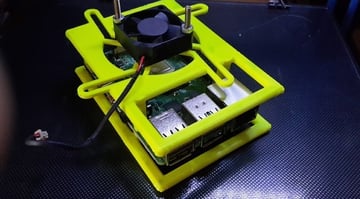- This is a quick remix from one of the most used Raspberry PI 2/3 cases to fit the new Raspberry PI 4. Edit: I made the first design based on the uGreen micro-HDMI to HDMI adapter. Amazon.de The official raspberry micro HDMI cable has a bigger micro HDMI connector. I added additional STL and step files to accomodate the bigger connector. As I do not own the official micro HDMI cable.
- Download files and build them with your 3D printer, laser cutter, or CNC. Thingiverse is a universe of things.
- Custom designed Raspberry Pi Case for the new Pi 4. Printed with 3 perimeters & No Top or bottom layers to leave infill visible. Fan is designed to be a friction fit in the lid so no fixings / glue are needed.
(Raspberry Pi 4 is too hard to get at the moment, but I will see if I can get one soon:P ) Raspberry Pi 4 support will definitely be added soon, with its on board USB3.0 port and Gigabyte Ethernet, it is the best board to setup a Raspberry Pi NAS. I will also release a new instructable on this topic soon with improved casing and software.
EDIT: I published an updated version of the NAS in amore recent article.
Network-Attached Storages (NAS) are very handy devices on a homenetwork. They offer a simple way to share or synchronize files, and canhost various useful services at the same time provided they are genericenough. A NAS being nothing more than a specialized file server, we willactually build a small home server than will be able to do anything.
The functions can be the following:

- File server (FTP, NFS, SMB/CIFS...)
- Streaming server (audio or video on the local network)
- Personal web server (to host a website, synchonize contacts or sendfiles to people)
- Local seedbox (to download torrent files)
- Domotic hub (for instance by adding a Zigbee USB dongle)
The server will be pretty simple in its technical design: a RaspberryPi 2 modelB withtwo hard disks connected with USB adapters.
The Raspberry Pi is actually not able to power the two drives over USB,since we would need 500mA per drive, so 1000mA overall, and the Pi canonly supply 600mA over USB. There is a possible boot setting in/boot/config.txt called max_usb_current, which when set to 1raises the maximum current intensity over USB to 1.2A, but since it isapplied only during boot, our disks will still prevent the Pi toactually start properly. For this reason, we need a USB hub with a 2Aadapter to power everything and connect the drives to the Pi.Backfeeding would be quite a bad idea, so the Pi needs to be connectedto the hub twice, once as a device for power and once as the host.
In this kind of setup, always pay attention to use a genuine poweradapter that will be able to handle the load, some really cheap adaptersare rated 2A but might not be able to supply this current over a longperiod of time due to overheating.
I designed the case, front panel and lid withOpenSCAD to print them in 3D. You candownload the SCAD source files and the corresponding STL fileshere (licensed underGPLv3).
3D models of the case, the front panel and the lid generated with OpenSCAD
The case has 4 levels: a 4-port powered USB hub at the bottom, thentwo 2.5' hard disks, and a Raspberry Pi on the top. The lid has alocation for a 25mm*25mm fan, connected to one of the Pi's powerpins.
The models are designed to be printed without supports, so they can beprinted directly as is. My printer is a Prusa Air2 with anE3D-v6 head, and I usePLA.

3D printing the NAS case, the process is long so let's have tea in the meantime :P
The 3D-printed case from the top, front parts are printed separately and glued
Raspberry Pi 4 Case Stl
Next, the front panel is glued to the case, the USB hub is installedwith two screws at the bottom, and the Raspberry Pi with four screws atthe top.
USB 2.0 hub in place into the NAS case, showing 4 USB ports on the front and the mini-B USB host port on the side. On the other side is the power input.
The Raspberry Pi in place on top of the the case with the USB power cable attached.
I chose to connect two 1 TB 2.5' hard disks with twoIB-AC6033-U3adapters from RaidSonic. They come with a case yet it can only fit 7mmdrives.
The final step is to attach the fan to the lid, connect it to one of thePi's power pins, and close the lid by clipping it in place.
Connecting the fan to the Raspberry Pi 3.3V pin
Raspberry Pi Case 3d Model
The NAS is now ready to run and can be configured! I chose to installRaspbian on the Pi's microSD card, andto set up the disks asRAID0 (ofcourse, never do so if you plan to store critical data). I might writearticles about configuration in the future, so stay tuned!